We’re trying to enlarge the subscriber base for the ExhaustNotes.us website. Our marketing efforts so far have been focused on sharing links on Facebook and posting links on various chat sites. It’s a hit and miss method that works okay and you can boost sponsored posts from Facebook but an email subscriber list may work even better. A subscriber email list would be by definition readers who are interested in our content.
In their heyday motorcycle magazines used to give away all sorts of cool gear plastered with logos. It built loyalty in an era when motorcyclists had many magazines to choose from. Today, with the zillions of websites to choose from will that kind of marketing work again?
 I guess we’ll find out. The first rough draft of the exhaustnotes.us sticker was a simple design using the popular, exhaust-pipe-streaming-off-a-letter style. This is not a new innovation but then neither is a motorcycle blog. The design needed to work with T-shirts and other future swag projects. We wanted it hand-drawn because Berk and I are old school and we are not wasting your time trying to appear otherwise.
I guess we’ll find out. The first rough draft of the exhaustnotes.us sticker was a simple design using the popular, exhaust-pipe-streaming-off-a-letter style. This is not a new innovation but then neither is a motorcycle blog. The design needed to work with T-shirts and other future swag projects. We wanted it hand-drawn because Berk and I are old school and we are not wasting your time trying to appear otherwise.
 Next we applied a little color to the design, not too much to keep costs down later on in the life of the logo. The chrome reflections and sky blue harken back to the Cycletoons/Cartoons magazines we read as whelps.
Next we applied a little color to the design, not too much to keep costs down later on in the life of the logo. The chrome reflections and sky blue harken back to the Cycletoons/Cartoons magazines we read as whelps.
 After we agreed on the layout the design was tightened up. The “E” fitted to the pipe better and the pipe was fatter and curved down more. We eliminated quotation marks on the motto and straightened out the lettering a bit.
After we agreed on the layout the design was tightened up. The “E” fitted to the pipe better and the pipe was fatter and curved down more. We eliminated quotation marks on the motto and straightened out the lettering a bit.
 Now the real work began: Inking the outlines and making every bold line pop out. We needed to make the design strong enough to survive shrinking in size or enlarging. A cheerful children’s watercolor set brightened things up without being hard to duplicate on clothing, stuff bags or tramp stamps.
Now the real work began: Inking the outlines and making every bold line pop out. We needed to make the design strong enough to survive shrinking in size or enlarging. A cheerful children’s watercolor set brightened things up without being hard to duplicate on clothing, stuff bags or tramp stamps.
 The final design was sent to www.JimmyMacDesigns.com for more refining, clean up and changing the whole jpeg mess into a vector file to prevent loss of data when resizing. Jimmy is a true artist. Go to his website to check out his fantastic metal and wood creations. You won’t be able to tell from these low-res blog photos but Jimmy got rid of all the tooling marks, made the letter edges sharp and resorted them to be more even without losing the hand-drawn look. He also made it fit into a standard oval sticker and added a ragged outside line on the oval.
The final design was sent to www.JimmyMacDesigns.com for more refining, clean up and changing the whole jpeg mess into a vector file to prevent loss of data when resizing. Jimmy is a true artist. Go to his website to check out his fantastic metal and wood creations. You won’t be able to tell from these low-res blog photos but Jimmy got rid of all the tooling marks, made the letter edges sharp and resorted them to be more even without losing the hand-drawn look. He also made it fit into a standard oval sticker and added a ragged outside line on the oval.
Here’s the deal: Sign up for ExhaustNotes.us email alerts and using a well-regulated yet self-funded government letter carrier we’ll send a brand new sticker suitable for framing to you for your effort. Just like in the old days except you don’t have to cut out box tops or coupons and crap. We only have a limited number of these to give away so you’ll need to get on the list before January 1st, 2054. You can email your snail mail address to Berk or me at info@ExhaustNotes.us after signing up. Sure, it’s a clunky process that will take a few weeks, but this is ExhaustNotes.us. If you want smooth and professional you should subscribe to the real magazines.

 East of Ruidoso, I steered the Husqvarna off of Highway 70 onto Devils Canyon Road and followed the twisting, smoothly-graded dirt until it dead-ended at Highway 220. Back on asphalt I turned right, rode past the airport and pulled into Fort Stanton, New Mexico.
East of Ruidoso, I steered the Husqvarna off of Highway 70 onto Devils Canyon Road and followed the twisting, smoothly-graded dirt until it dead-ended at Highway 220. Back on asphalt I turned right, rode past the airport and pulled into Fort Stanton, New Mexico. The Officers Quarters played host to Lieutenant John Pershing, who made good later on in life as General Black Jack Pershing. The OQ is divided into two story apartments with thick stone walls between. One section of the wall was damaged showing the rubble-filled core of the finished walls. This type of construction took a lot of manpower to build.
The Officers Quarters played host to Lieutenant John Pershing, who made good later on in life as General Black Jack Pershing. The OQ is divided into two story apartments with thick stone walls between. One section of the wall was damaged showing the rubble-filled core of the finished walls. This type of construction took a lot of manpower to build.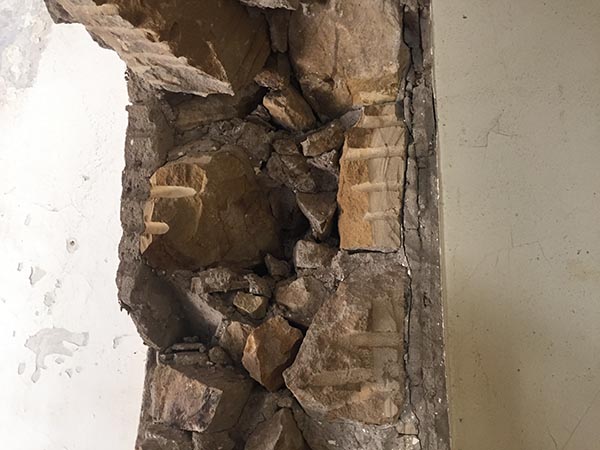
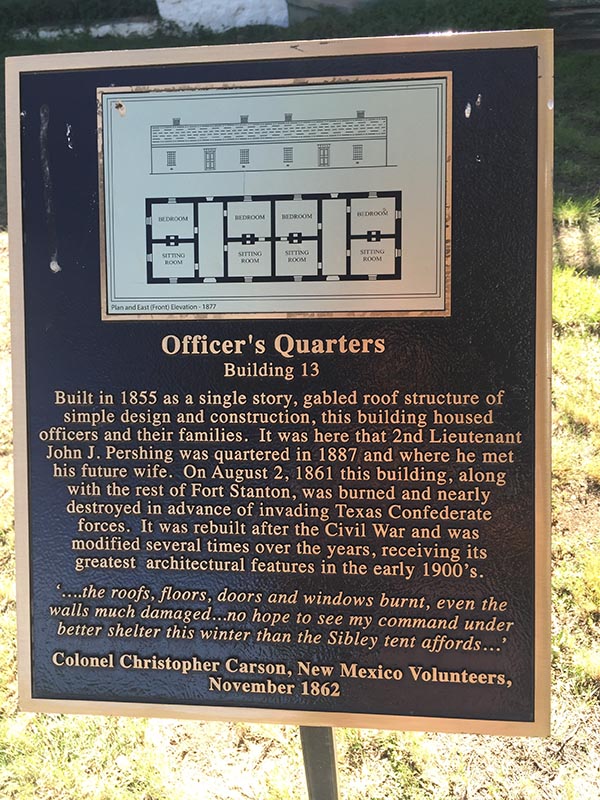 New Mexico’s clean dry air was the ideal spot to treat tuberculosis and in the 1930’s a modern hospital was built to care for easterners suffering from the unsanitary conditions prevailing at that time. The hospital sported New Mexico’s very first elevator along with dental facilities and entertainment. The patients however had to sleep outside in a tent city as it was believed plenty of fresh air and good food was the cure. It worked pretty well too.
New Mexico’s clean dry air was the ideal spot to treat tuberculosis and in the 1930’s a modern hospital was built to care for easterners suffering from the unsanitary conditions prevailing at that time. The hospital sported New Mexico’s very first elevator along with dental facilities and entertainment. The patients however had to sleep outside in a tent city as it was believed plenty of fresh air and good food was the cure. It worked pretty well too.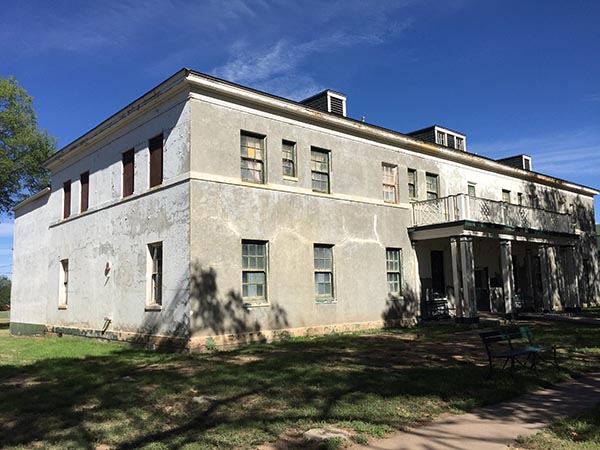 It’s ok to ride your motorcycle on the paved roads in the fort. On a back street there are more recent buildings and a nice stone church. I’m not into religion but I love to check out the buildings religious people have constructed. The little church at Fort Stanton is a jewel. It was open the day I was there and the place was clean and neat. For all I know believers may still worship here. You’re not allowed to tramp through the brush but behind the church a couple hundred yards are the remains of a swimming pool German prisoners of war built to stave off boredom and have a place to cool off in the summertime.
It’s ok to ride your motorcycle on the paved roads in the fort. On a back street there are more recent buildings and a nice stone church. I’m not into religion but I love to check out the buildings religious people have constructed. The little church at Fort Stanton is a jewel. It was open the day I was there and the place was clean and neat. For all I know believers may still worship here. You’re not allowed to tramp through the brush but behind the church a couple hundred yards are the remains of a swimming pool German prisoners of war built to stave off boredom and have a place to cool off in the summertime.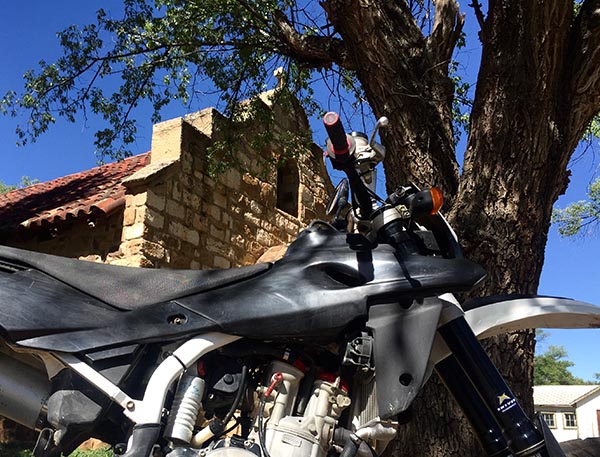
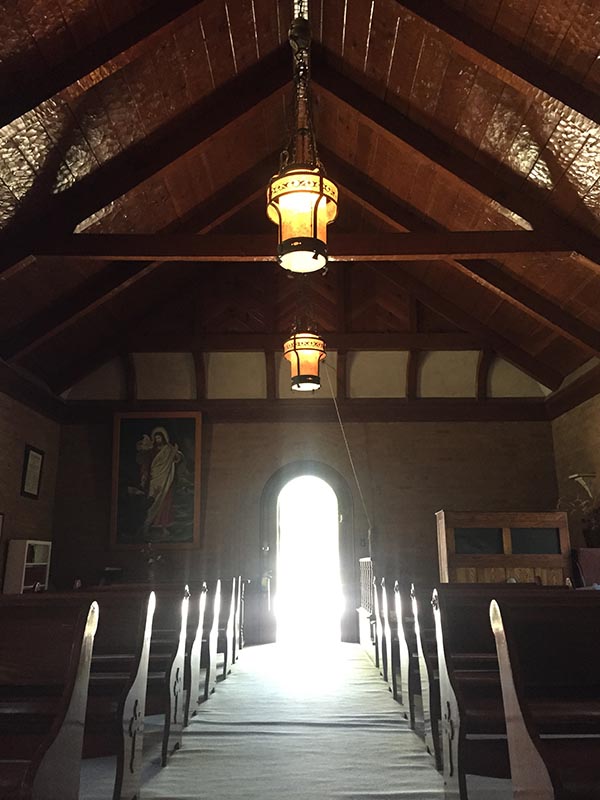 Right next door to the Officer’s Quarters is the Nurse’s quarters. I don’t know if the two uses ran concurrently but if they did this little corner of Fort Stanton must have been a happening spot. The Nurse’s quarters were in sad shape except for the main entrance, which had beautiful beams holding up the roof.
Right next door to the Officer’s Quarters is the Nurse’s quarters. I don’t know if the two uses ran concurrently but if they did this little corner of Fort Stanton must have been a happening spot. The Nurse’s quarters were in sad shape except for the main entrance, which had beautiful beams holding up the roof.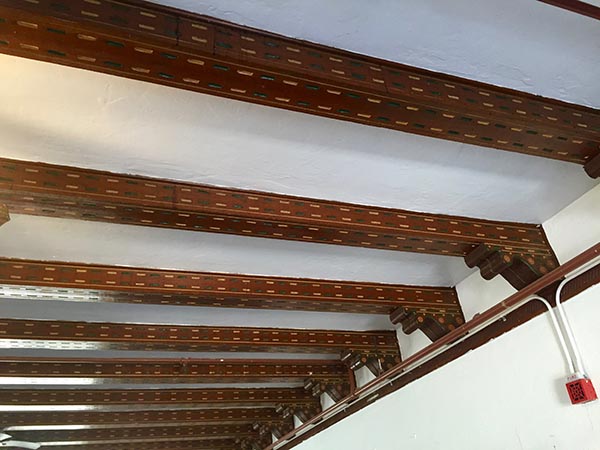 Fort Stanton isn’t overrun with tourists. Even though it was part of a war machine, wandering around inside the buildings gives you a sense of peace. Sit on one of the benches in the bright New Mexico sun and you can imagine the soldiers marching the grounds in formation; the gentle coughing of the slowly recovering patients and the laughter and splashing of lucky Germans who were spared death in World War 2.
Fort Stanton isn’t overrun with tourists. Even though it was part of a war machine, wandering around inside the buildings gives you a sense of peace. Sit on one of the benches in the bright New Mexico sun and you can imagine the soldiers marching the grounds in formation; the gentle coughing of the slowly recovering patients and the laughter and splashing of lucky Germans who were spared death in World War 2.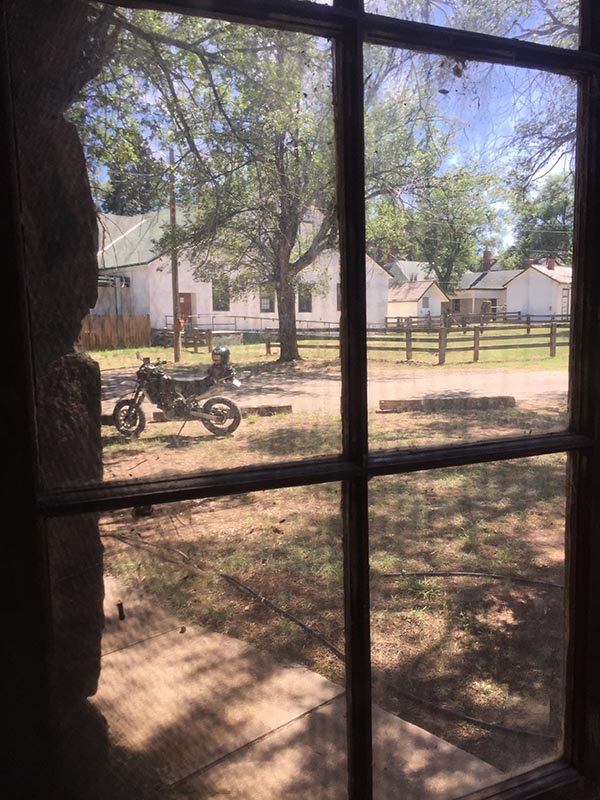
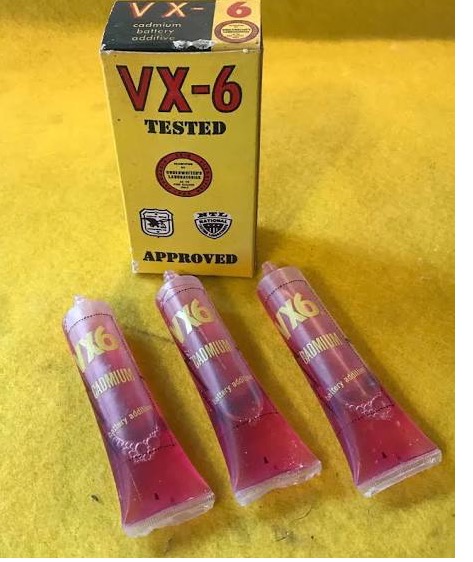 I had a 1954, small-window Dodge truck back in the 1970’s. It’s funny how a 20 year-old truck seemed so much older when I was younger. My 1990 Suburban is the same age now as the old Dodge was then but the Suburban seems modern to me. I can remember new Suburban’s rolling off the dealer lots that looked exactly like mine. I wasn’t even alive when the ’54 dodge was built.
I had a 1954, small-window Dodge truck back in the 1970’s. It’s funny how a 20 year-old truck seemed so much older when I was younger. My 1990 Suburban is the same age now as the old Dodge was then but the Suburban seems modern to me. I can remember new Suburban’s rolling off the dealer lots that looked exactly like mine. I wasn’t even alive when the ’54 dodge was built.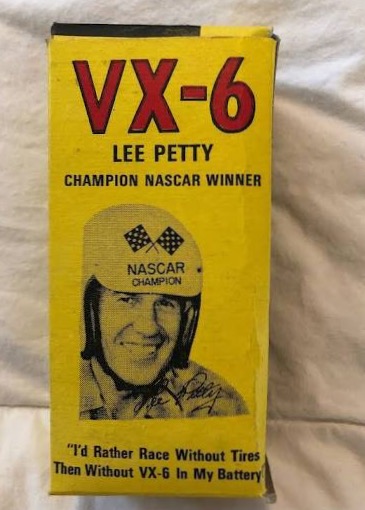 What the heck, Lee Petty endorsed VX-6, he said he’d rather run without tires than his VX-6. That was good enough for me. Lee Petty does not bullshit. So I dumped the stuff in the nearly dead 8-volt battery and let it sit overnight. The next morning I tried the starter and the engine started like it had a new battery.
What the heck, Lee Petty endorsed VX-6, he said he’d rather run without tires than his VX-6. That was good enough for me. Lee Petty does not bullshit. So I dumped the stuff in the nearly dead 8-volt battery and let it sit overnight. The next morning I tried the starter and the engine started like it had a new battery. There are more ways to measure wealth than money. Sure, traditionalists rely on a strict net worth approach, adding up the figures on electronic statements in a system where the winner is whoever has the highest number. You can count all sorts of things, though. You can count friends, you can count grandchildren, you can count experiences: These are forms of wealth that won’t show up on that balance email from the bank.
There are more ways to measure wealth than money. Sure, traditionalists rely on a strict net worth approach, adding up the figures on electronic statements in a system where the winner is whoever has the highest number. You can count all sorts of things, though. You can count friends, you can count grandchildren, you can count experiences: These are forms of wealth that won’t show up on that balance email from the bank. On of my largest assets is the 4-speed Suburban project. When I bought the ’90 ‘Burb it came with a malfunctioning automatic transmission. I hate automatics and malfunctioning ones even more so. The 700R4 works in Drive and Reverse but not in 1-2-3. The truck runs fine and it will tote a 3000-pound load without complaint but that boring automatic has got to go. It’s a rare Suburban that came with a 4-speed from the factory and even rarer to see a ½-ton version. I’ve only seen one 4-speed ‘Burb and it was ¾-on. This project keeps earning interest and I’ve been training a weather eye on Internet sale sites for a cheap, manual transmission, 4X4 GM truck to steal the guts from. I found a late model, 4X4-IFS 1/2-ton truck with a 5-speed and a nice FI engine that ran well but the transfer case and transmission housing were broken and besides everything was on the wrong side for the old straight axle suburban.
On of my largest assets is the 4-speed Suburban project. When I bought the ’90 ‘Burb it came with a malfunctioning automatic transmission. I hate automatics and malfunctioning ones even more so. The 700R4 works in Drive and Reverse but not in 1-2-3. The truck runs fine and it will tote a 3000-pound load without complaint but that boring automatic has got to go. It’s a rare Suburban that came with a 4-speed from the factory and even rarer to see a ½-ton version. I’ve only seen one 4-speed ‘Burb and it was ¾-on. This project keeps earning interest and I’ve been training a weather eye on Internet sale sites for a cheap, manual transmission, 4X4 GM truck to steal the guts from. I found a late model, 4X4-IFS 1/2-ton truck with a 5-speed and a nice FI engine that ran well but the transfer case and transmission housing were broken and besides everything was on the wrong side for the old straight axle suburban. The chalky blue, 1974 MG GT came with Tinfiny Ranch and was listed as an out building on the deed. This car was on the chopping block until I started reading about MG’s with Buick 215 cubic-inch aluminum engine swaps. I really have to stay off the internet. The Buick engine triples the horsepower, doesn’t weigh much more than the iron 4-banger it replaces and sounds cool as hell revved up to 6000 RPM. This is one asset I kind of wish was not in my Project Bank as I’ve never been that interested in cars. Still, it’s there waiting on me.
The chalky blue, 1974 MG GT came with Tinfiny Ranch and was listed as an out building on the deed. This car was on the chopping block until I started reading about MG’s with Buick 215 cubic-inch aluminum engine swaps. I really have to stay off the internet. The Buick engine triples the horsepower, doesn’t weigh much more than the iron 4-banger it replaces and sounds cool as hell revved up to 6000 RPM. This is one asset I kind of wish was not in my Project Bank as I’ve never been that interested in cars. Still, it’s there waiting on me. Tinfiny Ranch itself is a huge source of endless work, but beyond the physical plant The Ranch continues to deposit surprises into my Project Bank. This Merry Tiller project revealed itself as I was hauling away two, multi-panel garage doors. The doors sections were stacked with spacers in the popular rat-paradise fashion and I gave chase to a couple fat rats but they got away from me in the thick brush down by the ravine. The Merry Tiller looks like it will come in handy for the raised-bed vegetable garden (yet another deposit in The Project Bank) I’m planning for the back yard. The engine on the tiller is not stuck and being a Briggs & Stratton I’m sure it will run so I’m leaving it in The Bank for safe keeping.
Tinfiny Ranch itself is a huge source of endless work, but beyond the physical plant The Ranch continues to deposit surprises into my Project Bank. This Merry Tiller project revealed itself as I was hauling away two, multi-panel garage doors. The doors sections were stacked with spacers in the popular rat-paradise fashion and I gave chase to a couple fat rats but they got away from me in the thick brush down by the ravine. The Merry Tiller looks like it will come in handy for the raised-bed vegetable garden (yet another deposit in The Project Bank) I’m planning for the back yard. The engine on the tiller is not stuck and being a Briggs & Stratton I’m sure it will run so I’m leaving it in The Bank for safe keeping.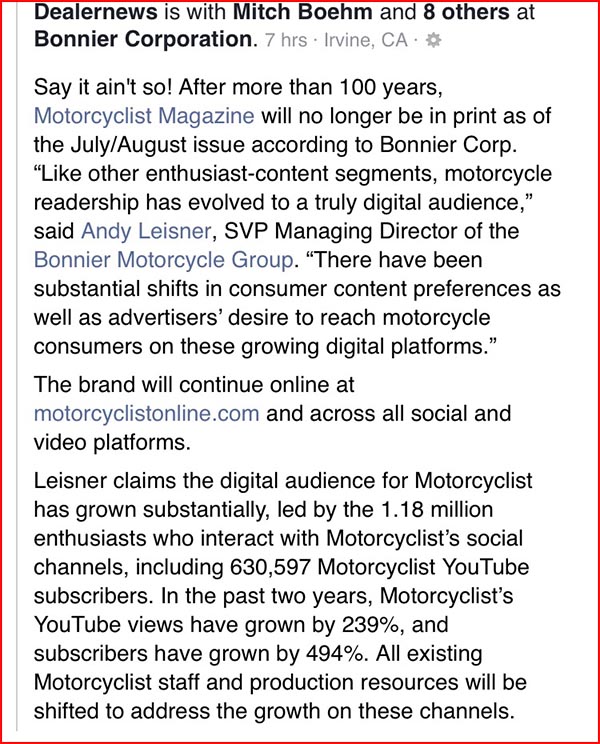 The distance from being read in the crapper and actually being in the crapper is a short one. According to Dealer News, Motorcyclist magazine crossed that span this week. I’m not happy about it. In fact, I’m well pissed-off. Over 100 years of print publication down the tubes. I was a part of that glorious history for 10 years. MC mag was always my favorite. They had Burns, they had Boehm, they had Frank and they had that crazy kid that kept crashing GSXR’s. MC mag was way cooler and funnier than stodgy old corporate-Cycle World. When I first decided to submit motorcycle stories for publication MC mag was the only place I submitted to.
The distance from being read in the crapper and actually being in the crapper is a short one. According to Dealer News, Motorcyclist magazine crossed that span this week. I’m not happy about it. In fact, I’m well pissed-off. Over 100 years of print publication down the tubes. I was a part of that glorious history for 10 years. MC mag was always my favorite. They had Burns, they had Boehm, they had Frank and they had that crazy kid that kept crashing GSXR’s. MC mag was way cooler and funnier than stodgy old corporate-Cycle World. When I first decided to submit motorcycle stories for publication MC mag was the only place I submitted to. Bonnier bought most of the USA’s larger motorcycle magazines a few years back and instead of finding a way they have shuttered magazine after magazine. They’ve managed to turn the largest motorcycle enthusiast’s print group into a damn Internet blog. What a stunning waste of money. Bonnier is supposed to be the experts. The much-touted single-source vertical integration has become a major horizontal screw-up. Thanks guys. Thanks for screwing up nearly everything I liked about your books.
Bonnier bought most of the USA’s larger motorcycle magazines a few years back and instead of finding a way they have shuttered magazine after magazine. They’ve managed to turn the largest motorcycle enthusiast’s print group into a damn Internet blog. What a stunning waste of money. Bonnier is supposed to be the experts. The much-touted single-source vertical integration has become a major horizontal screw-up. Thanks guys. Thanks for screwing up nearly everything I liked about your books. Bonnier’s press release tries to spin the magazine’s closure in the best possible light citing MC’s huge social media reach. Most of those puffy numbers are a direct result of Brian Hatano’s work years ago and Ari/Zack’s well done YouTube channel. Anyway, as Berk and I have learned, Facebook friends do not equal views. When a page with a million-plus followers puts up an interesting post and gets two comments, I’m telling you the reach is just not there. I get more response from a post about adobe blocks.
Bonnier’s press release tries to spin the magazine’s closure in the best possible light citing MC’s huge social media reach. Most of those puffy numbers are a direct result of Brian Hatano’s work years ago and Ari/Zack’s well done YouTube channel. Anyway, as Berk and I have learned, Facebook friends do not equal views. When a page with a million-plus followers puts up an interesting post and gets two comments, I’m telling you the reach is just not there. I get more response from a post about adobe blocks.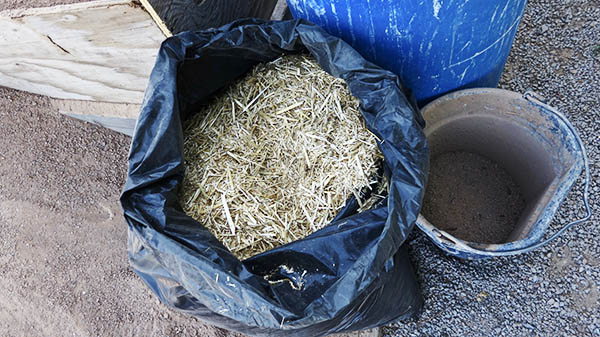 It takes 60 shovelfuls to fill the adobe mixer. Originally designed for mortar, the outside drum of our mixer looks like an inverted lunar landscape. Dimples as large as a quarter, back when a quarter was worth 25 cents, protrude far enough to run afoul of the mixer’s I-beam chassis. It’s the rocks, see? Mixing adobe eats up the rubber wiper blades on the paddles and as the gap between the blade and the drum grows larger things start going south. When the gap grows large enough the mixer paddles wedge into the rocks and a sharp pop, like someone hit the machine with a 16-pound sledgehammer, is followed by a lurch of the heavy machine. Another dimple has been created. If the conditions are just right the mixer blades will lock up solid and it takes a quick hand on the clutch lever to prevent a smoking V-belt.
It takes 60 shovelfuls to fill the adobe mixer. Originally designed for mortar, the outside drum of our mixer looks like an inverted lunar landscape. Dimples as large as a quarter, back when a quarter was worth 25 cents, protrude far enough to run afoul of the mixer’s I-beam chassis. It’s the rocks, see? Mixing adobe eats up the rubber wiper blades on the paddles and as the gap between the blade and the drum grows larger things start going south. When the gap grows large enough the mixer paddles wedge into the rocks and a sharp pop, like someone hit the machine with a 16-pound sledgehammer, is followed by a lurch of the heavy machine. Another dimple has been created. If the conditions are just right the mixer blades will lock up solid and it takes a quick hand on the clutch lever to prevent a smoking V-belt.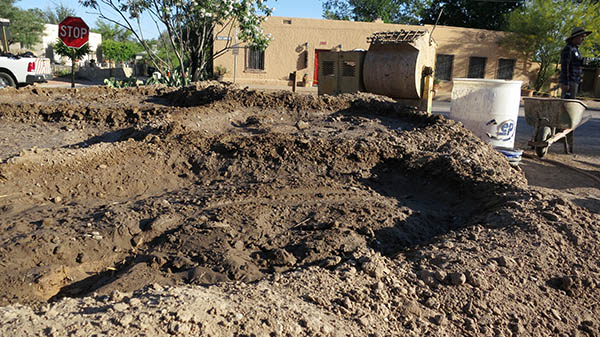 With adobe mixing the show must go on so Pappy and I work in silence. Not total silence though, because we have to keep count of how many shovels we are throwing into the hopper. “I’m at 13,” I tell Pappy. “15” for me, Pappy replies. The mixer locks up, I grab the clutch. We move loaded buggies to the block-making area then we shovel more dirt into the hopper. Soon the injury is forgotten. “Is that good?” “More water.” Pappy says. “4 more shovelfuls.” “Ok, that’s good. Let’s let it mix” Pappy feels bad about yelling at me, I feel bad for hurting Pappy. We are a team again. I’ve got to be more careful working around others.
With adobe mixing the show must go on so Pappy and I work in silence. Not total silence though, because we have to keep count of how many shovels we are throwing into the hopper. “I’m at 13,” I tell Pappy. “15” for me, Pappy replies. The mixer locks up, I grab the clutch. We move loaded buggies to the block-making area then we shovel more dirt into the hopper. Soon the injury is forgotten. “Is that good?” “More water.” Pappy says. “4 more shovelfuls.” “Ok, that’s good. Let’s let it mix” Pappy feels bad about yelling at me, I feel bad for hurting Pappy. We are a team again. I’ve got to be more careful working around others.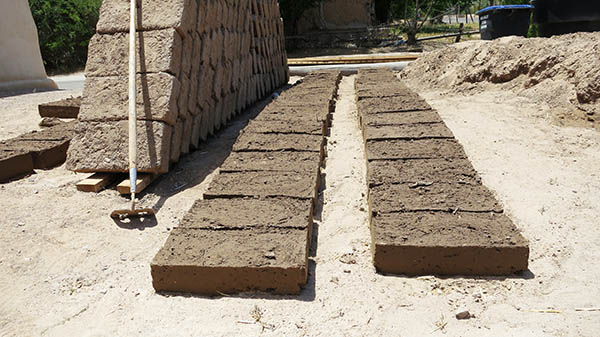 “Who wants to give it a try?” Pat asks and several would-be adobe builders jump in and start laying blocks. Instead of cement mortar, more mud is used to set the Adobe blocks. I’m cutting a bevel into the blocks to create a space for small volcanic rocks. The rocks are fitted into the bevels and held in with a white lime mortar. Once these protruding rocks are set the lime plaster will adhere to the rocks, hopefully keeping the plaster from sloughing off the wall.
“Who wants to give it a try?” Pat asks and several would-be adobe builders jump in and start laying blocks. Instead of cement mortar, more mud is used to set the Adobe blocks. I’m cutting a bevel into the blocks to create a space for small volcanic rocks. The rocks are fitted into the bevels and held in with a white lime mortar. Once these protruding rocks are set the lime plaster will adhere to the rocks, hopefully keeping the plaster from sloughing off the wall.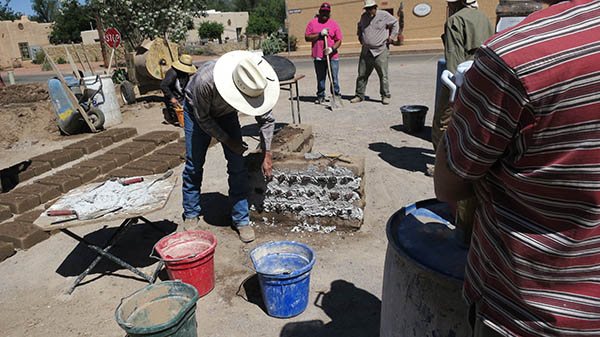 There’s another, even older method of finishing adobe walls borne from necessity: More mud. Mud plaster doesn’t last as long as lime plaster but if you don’t have lime what’s a poor boy to do? Think of mud plaster as a sacrificial coating. It erodes so that the adobe blocks underneath don’t. Mud plaster is applied by hand or trowel, and re-applied every few years as needed. As Pat’s students, we got to try all application methods with special emphasis on the difficult ones.
There’s another, even older method of finishing adobe walls borne from necessity: More mud. Mud plaster doesn’t last as long as lime plaster but if you don’t have lime what’s a poor boy to do? Think of mud plaster as a sacrificial coating. It erodes so that the adobe blocks underneath don’t. Mud plaster is applied by hand or trowel, and re-applied every few years as needed. As Pat’s students, we got to try all application methods with special emphasis on the difficult ones.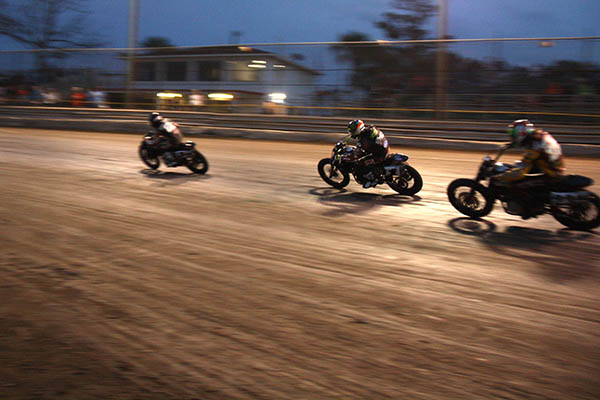 In San Diego I lived across the street from a Safeway food market. Man, I never ran out of anything. That Safeway is now a West Marine boat supply store. They got nothing to eat in the whole damn place. But back then, around 1980, it was a great food source.
In San Diego I lived across the street from a Safeway food market. Man, I never ran out of anything. That Safeway is now a West Marine boat supply store. They got nothing to eat in the whole damn place. But back then, around 1980, it was a great food source. The only camera that survived our 40-day, Zongshen RX3 China tour was the one inside my cell phone. My Canon 5D, that weighs a ton, broke its battery door and the 28-135 zoom lens actually fractured and stopped zooming. It sounds like the gears inside are broken. Both were inside a padded camera bag and the bag was wrapped in extra clothing. Don’t let anyone tell you we didn’t pound on those Zongshen RX3’s.
The only camera that survived our 40-day, Zongshen RX3 China tour was the one inside my cell phone. My Canon 5D, that weighs a ton, broke its battery door and the 28-135 zoom lens actually fractured and stopped zooming. It sounds like the gears inside are broken. Both were inside a padded camera bag and the bag was wrapped in extra clothing. Don’t let anyone tell you we didn’t pound on those Zongshen RX3’s. My go-to travel camera, a little Canon S95, also could not survive the rough Chinese trails we explored. The S95 suffered a broken screen and refused to boot up due to a broken top plate. Again, this camera was in my jacket pocket and not rattling around in a bag. We ride hard, you know?
My go-to travel camera, a little Canon S95, also could not survive the rough Chinese trails we explored. The S95 suffered a broken screen and refused to boot up due to a broken top plate. Again, this camera was in my jacket pocket and not rattling around in a bag. We ride hard, you know? Here you can see the extra bit of zoom. S100 on left.
Here you can see the extra bit of zoom. S100 on left. I researched the camera forums and found some S100 owners never have the lens error and of those that did a ribbon wire falling out of its socket was the cause for most of the failures. So I bit on a sweet 100-dollar, S100 that looks like brand new and seems to function perfectly.
I researched the camera forums and found some S100 owners never have the lens error and of those that did a ribbon wire falling out of its socket was the cause for most of the failures. So I bit on a sweet 100-dollar, S100 that looks like brand new and seems to function perfectly. The S100 boots up noticeably faster than the S95 but I am never in that much of a hurry. It will burst a bunch of shots faster than the old model. This may come in handy for action shots. The wide-angle lens is only noticeable when comparing both cameras side by side. When it comes to photography, more is always better. I’m happy with the little S100 and can’t wait to try it out on a motorcycle trip. If I ever go on another motorcycle trip, that is.
The S100 boots up noticeably faster than the S95 but I am never in that much of a hurry. It will burst a bunch of shots faster than the old model. This may come in handy for action shots. The wide-angle lens is only noticeable when comparing both cameras side by side. When it comes to photography, more is always better. I’m happy with the little S100 and can’t wait to try it out on a motorcycle trip. If I ever go on another motorcycle trip, that is. Here at ExhaustNotes.us we are all about the motorcycle, with a smattering of gunplay and interesting adventure destinations thrown in to keep the place hopping. But what if there were no bikes, adventures or bullets? What then? Keep reading and I’ll tell you what then, Bubba.
Here at ExhaustNotes.us we are all about the motorcycle, with a smattering of gunplay and interesting adventure destinations thrown in to keep the place hopping. But what if there were no bikes, adventures or bullets? What then? Keep reading and I’ll tell you what then, Bubba.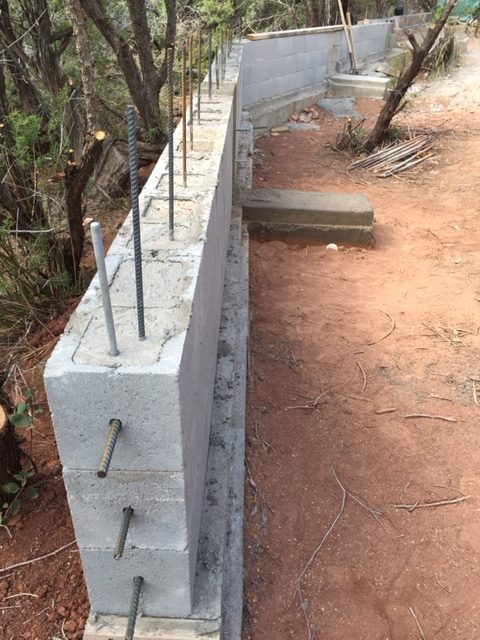 Situated in the steep-ish foothills of the Sacramento Mountains, Tinfiny Ranch is slowly bleeding into the arroyo, you know? You put down your cold, frosty beer and the next thing you know your Stella is halfway to White Sands National Monument. On the lee side of The Carriage House we’ve lost a good 18-inches of mother earth because while it doesn’t rain often in New Mexico when it does rain it comes down in buckets. This sudden influx of water tears through Tinfiny Ranch like freshly woken kittens and sweeps everything in its path down, down, down, into the arroyo and from there on to the wide, Tularosa Valley 7 miles and 1500 feet below. Claiming dominion over the land is not as easy as they make it sound.
Situated in the steep-ish foothills of the Sacramento Mountains, Tinfiny Ranch is slowly bleeding into the arroyo, you know? You put down your cold, frosty beer and the next thing you know your Stella is halfway to White Sands National Monument. On the lee side of The Carriage House we’ve lost a good 18-inches of mother earth because while it doesn’t rain often in New Mexico when it does rain it comes down in buckets. This sudden influx of water tears through Tinfiny Ranch like freshly woken kittens and sweeps everything in its path down, down, down, into the arroyo and from there on to the wide, Tularosa Valley 7 miles and 1500 feet below. Claiming dominion over the land is not as easy as they make it sound. After the wall is up the resulting divot will require filling with dirt. I have lots of dirt on Tinfiny Ranch; the conundrum is where to borrow it from without causing even more erosion. I’m hoping that leveling the back yard will provide most of the needed fill.
After the wall is up the resulting divot will require filling with dirt. I have lots of dirt on Tinfiny Ranch; the conundrum is where to borrow it from without causing even more erosion. I’m hoping that leveling the back yard will provide most of the needed fill.
 Most all of the fun things we did as little kids were instigated by my Grandparents. Between raising four kids and working constantly to pay for the opportunity our parents were left spent, angry and not that into family-time trips. We did try it a few times but it seems like the trips always ended with someone crying, my parents arguing or a small child missing an arm. With only 16 limbs between us we had to be careful and husband our togetherness for fear of running out.
Most all of the fun things we did as little kids were instigated by my Grandparents. Between raising four kids and working constantly to pay for the opportunity our parents were left spent, angry and not that into family-time trips. We did try it a few times but it seems like the trips always ended with someone crying, my parents arguing or a small child missing an arm. With only 16 limbs between us we had to be careful and husband our togetherness for fear of running out. We always bought infield tickets. Camping at the Daytona Speedway was included with infield tickets so we immersed ourselves in the racing and never had to leave. Gramps had a late 1960’s Ford window van with a 6-cylinder, 3-on-the-tree drivetrain. The van was fitted out inside with a bed and had a table that pivoted off the forward-most side door. To give us a better view of the racing Gramps built a roof rack out of 1” tubing. The rack had a ¾” plywood floor and was accessed via a removable ladder that hung from the rack over the right rear bumper.
We always bought infield tickets. Camping at the Daytona Speedway was included with infield tickets so we immersed ourselves in the racing and never had to leave. Gramps had a late 1960’s Ford window van with a 6-cylinder, 3-on-the-tree drivetrain. The van was fitted out inside with a bed and had a table that pivoted off the forward-most side door. To give us a better view of the racing Gramps built a roof rack out of 1” tubing. The rack had a ¾” plywood floor and was accessed via a removable ladder that hung from the rack over the right rear bumper. When you would climb the ladder to the upper deck your hands would pick up silver paint. If you sat on the deck your pants would turn silver. If you rubbed your nose like little kids do your nose would turn silver. It was like Gramps painted the deck with Never-Seez. After a full day of racing we looked like little wads of Reynolds Wrap.
When you would climb the ladder to the upper deck your hands would pick up silver paint. If you sat on the deck your pants would turn silver. If you rubbed your nose like little kids do your nose would turn silver. It was like Gramps painted the deck with Never-Seez. After a full day of racing we looked like little wads of Reynolds Wrap. Our camp stove was a two-burner alcohol fueled unit that, incomprehensibly, used a glass jar to contain the alcohol. Even to my 10 year-old eyes the thing looked like a ticking time bomb so I kept my distance while gramps lit matches and cussed at the stove.
Our camp stove was a two-burner alcohol fueled unit that, incomprehensibly, used a glass jar to contain the alcohol. Even to my 10 year-old eyes the thing looked like a ticking time bomb so I kept my distance while gramps lit matches and cussed at the stove.